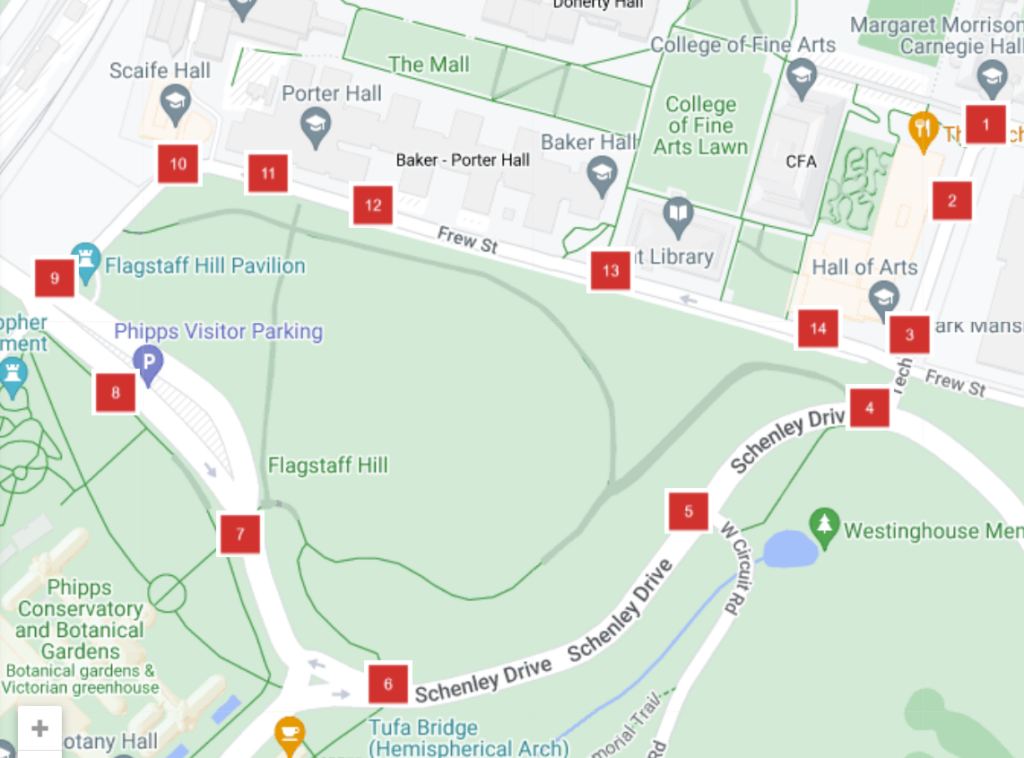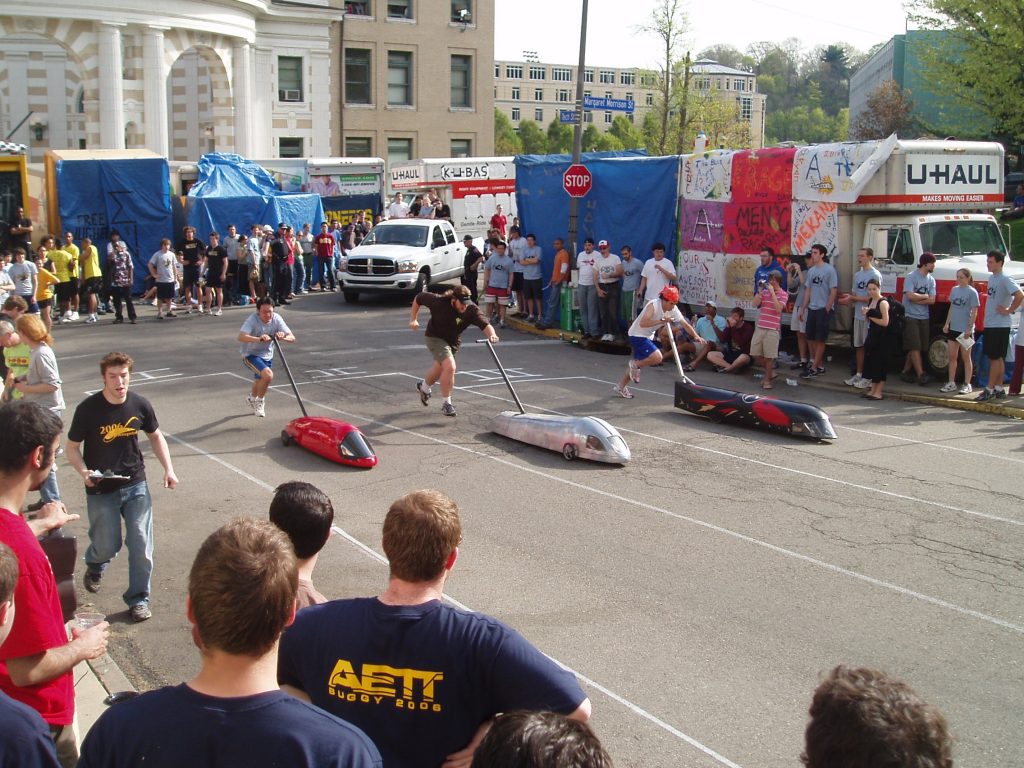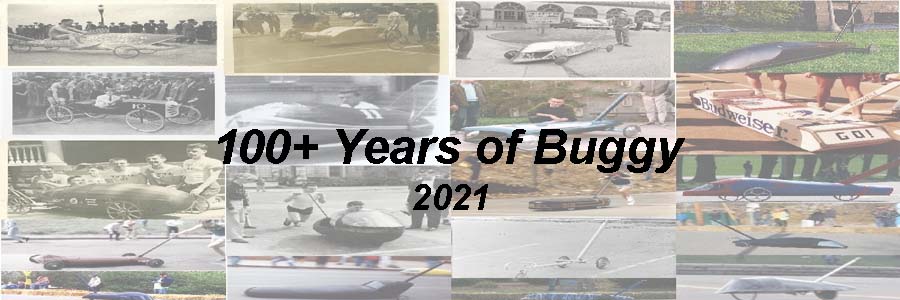Welcome to the course! Whether you follow along while you take a walk around Schenley Park or opt to explore the course virtually, this tour aims to provide some insight into the sport of Buggy at CMU! This tour begins at the intersection of Margaret Morrison and Tech St and works clockwise around Flagstaff Hill. You can use either the map below or the link to Google Maps to navigate!

(1) Start Line — Start of Tour
Welcome to the Buggy Course! During this self-guided tour, you’ll be able to follow along along the 0.8 mile course that the buggies complete.

(2) Hill 1 — Overview of Buggy
Buggy, formally known as the Sweepstakes Races is a race held annually at Carnegie Mellon’s Spring Carnival where teams of students race vehicles that they have designed and built around Schenley Park. Buggy originally started in 1920 and has remained an ongoing tradition at Carnegie Mellon over the past 100 years. In that time, the rules and regulations of the sport have evolved along with technological advances that make the buggies what they are today.

(3) Hill 1/2 Transition — A Relay Race (of sorts)
Of course, this race is different from many others. The buggies themselves aren’t able to have internal power sources, but the course consists of 2 uphill sections and 1 downhill section. A team of pushers is required to move the buggies uphill. The first uphill portion is broken into 2 sections, known as Hill 1 and Hill 2. There are an additional 3 “Hills” for the second uphill portion. This area around this stop sign is the first of four transition zones, where one pusher is able to pass off control of the buggy to the next pusher.

(4) Hill 2 Pushoff — The Freeroll
Now, we start into the downhill portion of the race, known as the “freeroll.” At this point, the driver is in complete control of the buggy. The roads look a lot different from 2 inches off the ground! They get experience from a lot of practice and some teams like to review their driving with the aid of go pros. There are a couple of navigation aids that the drivers use as well. There is a flag that aids them as they come over the 3 way intersection and cross over the road. Teams have another flag set up right before drivers make a big turn into the chute.

(5) Circuit Road — What are Rolls?
We aren’t able to come out and practice on the public roads whenever we want. Each weekend (weather permitting), the governing body of Sweepstakes secures road permits that allows teams to practice safely without road traffic during Freeroll practices, or “rolls”. The time teams have to practice runs from sunrise to 9AM. However, students really come out even earlier as each buggy has to pass a safety check and each team completes their chores necessary to prepare the course for practice. Outside of these weekend rolls, many teams continue to work on their buggies throughout the week.

(6) Trisection — Buggy Mechanics
We’re now passing the three way intersection where buggies turn off to the right, back towards Pitt. Now, we’ll also be going over some of the different roles look like from a student’s perspective. First up are the mechanics. The responsibilities for what these people do varies from team to team. Generally they do all of the work to make sure their buggies are maintained in order to roll each weekend, however some mechanics also end up leading major repairs, or own the design and construction of new buggies. Each team has their own schedule for how they perform maintenance or how frequently they build. Some teams build every year, while others build every few years. Some teams, especially when they’re first getting started may even have a “loaner” buggy that they can use to get used to the week-to-week operations before committing to a build of their own.


(7) Transition Flag — Different Teams
We’re now at the location of the first signal flag that directions drivers across the road. While this sport started out an activity for fraternities, the sport has continued to expand, with a roster of teams split between fraternities, sororities, independent organizations, and even some teams developing robotic buggies. Students have a wide variety of choice when it comes to choosing a team that best fits them. For drivers, this is a literal fit! Each team has a different method for building their buggies, different cultures, and expectations for involvement.

(8) Chute Flag — Buggy Drivers
We’re now around where the second signal flag is. These flags are essential, since yes, there really is a person inside! The driver is responsible for navigating the buggies around the course. They practice over the course of the year to get well accustomed to their steering and brakes, as well as being able to locate themselves on the course when 2 inches off the ground! They also work to get more comfortable driving faster and improving their racing line.

(9) Chute Entrance — The Chute Turn
We’re now coming up on one of the most prominent features of the course — the Chute Turn. This section of the course is where both buggies and drivers can show off what they’re capable of! Experienced buggy watchers look for the racing line each driver takes, how cleanly they take it, and how much speed they are able to maintain going up to Hill 3.

(10) Chute — Safety in the Bylaws
Over time, we have developed an extensive set of regulations to ensure our drivers are safe. There are rules that deal with the construction of the buggy, checking the steering, brakes, and safety anchors. Drivers also must complete training to help them learn about their safety equipment and the course before they ever get on the course. We also limit their speed for the first few times around the course to familiarize themselves with being in a buggy.


(11) Hill 3 — Buggy Pushers
At the end of the chute, we reach the location where the “Back Hills” pushers pick up the buggy and run with it up our second hill. For each team, there are 5 pushers spread out and assigned to the different hills. While originally these pushers were made up of all men, we have slowly introduced other divisions over time. The women’s races began in 1979, and the mixed All Gender division was introduced in 2023. Today, the course records stand at 2:02 for the men’s, 2:23 for the women’s, and 2:36 for the all gender. Pushers get in practice during rolls, not only as a workout, but to train the technical aspect of pushing a vehicle smoothly while running.

(12) Hill 3/4 Transition — Different Hills
We talked earlier about the different hills for each of the 5 pushers. However, while all of these section are uphill, each requires a slightly different skill set in order to be a successful pusher. While for all hills it’s useful to be strong and fast, the hills each have their own character. The first hill, Hill 1 requires explosive power to bring a buggy up to speed and up one of the steepest sections of the course. Hill 2 is about getting the buggy as much energy as possible before the freeroll, but they don’t have to worry as much about pushing uphill or stamina as it’s fairly short and ends with a downhill. Hill 3 is fairly technical, with the most important part being the “pickup” — this is all about matching the speed of the buggy as it starts to roll uphill and maintaining as much speed as possible heading into the back hills. Hill 4 is another steep section and test of endurance, as it’s slightly longer than Hill 1. Hill 5 is a test of pure speed. This hill levels out and is almost a pure sprint for around 150 meters.

(13) Hill 4/5 Transition — Carnival
All of this training and preparation is done in services of the races themselves, held during Spring Carnival, which runs from Thursday through Saturday. On Thursday, buggies compete in the Design Competition, which seeks to judge a team on their engineering merits when designing and building a buggy. Friday holds the preliminary races — a set of time trials that narrows the field down to the top 10 teams of each division. The finals are then on Saturday, when the teams that advanced to the finals are able to race for the overall top time.



(14) Finish Line — Conclusions
We’ve arrived at the finish line! You’ve officially walked the entire length of our buggy course. To put that in perspective, the current men’s course record stands at 2:02, and the women’s at 2:23. Thanks for coming on this tour and being interested in learning about Buggy. If you still want to learn more, the BAA serves as a great resource for historical data, current news, and ways to support the sport.






